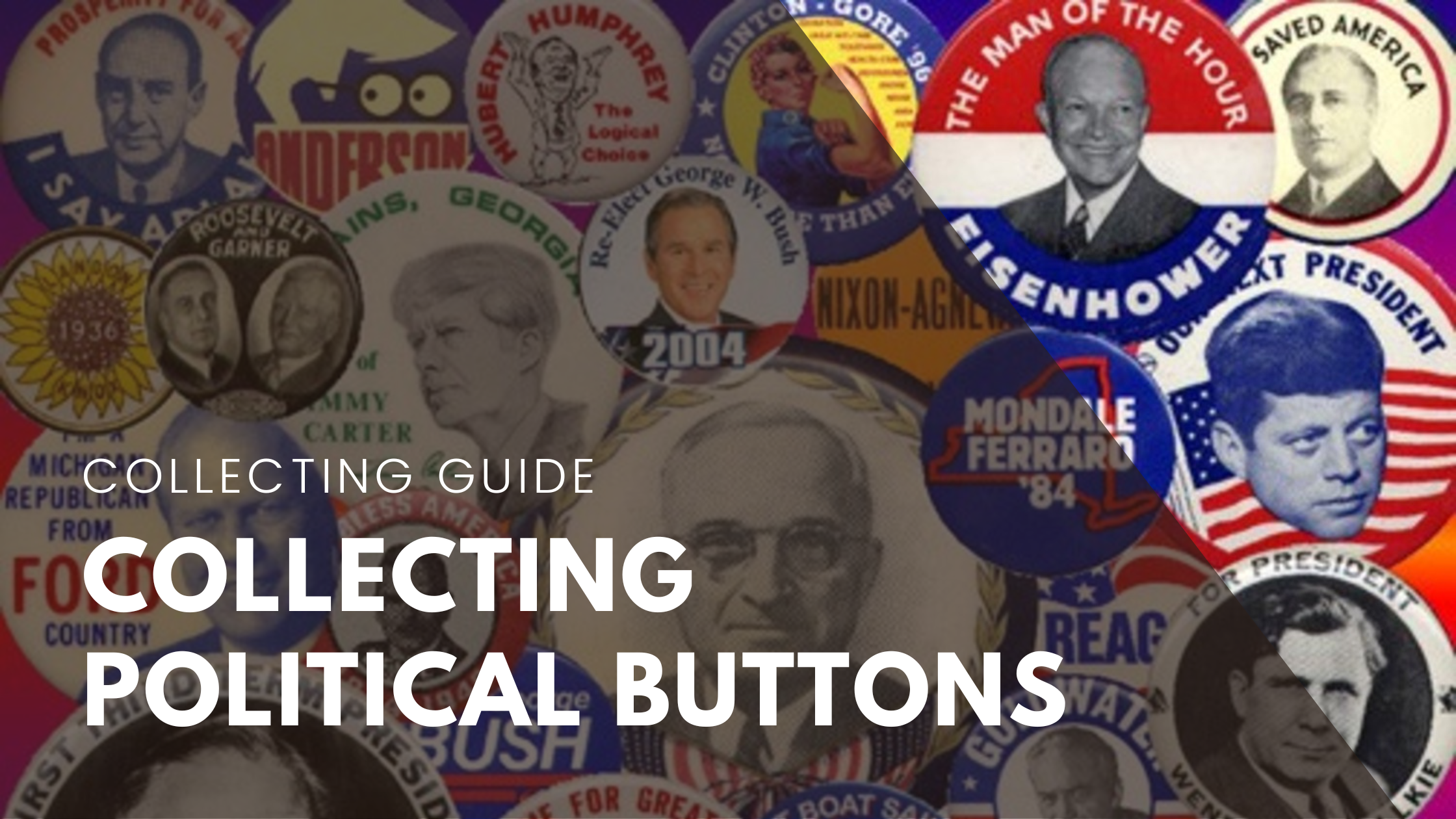Collecting Political Buttons: A Window into Political History
Political buttons, also called campaign buttons or political badges, have significantly shaped political history worldwide. These small yet powerful items serve as visual symbols of support, advocacy, and political affiliation. From early political campaigns to contemporary movements, the evolution of political buttons reflects the shifting tides of social and political landscapes.
For collectors and enthusiasts, this post explores the world of political button collecting. We'll share tips on how to start a collection, identify fakes and reproductions, and provide insight into the history of political buttons in the United States.
A Brief History of Political Buttons
Early Origins: The use of political buttons can be traced back to the early 18th century in the United States. The first known political buttons were brass clothing buttons made for Washington's inauguration, including some engraved with Long Live the President and others engraved with just his initials. The buttons sewn into Washington's jacket featured 13 chain links surrounding the button's border, which represented the original 13 states. However, it wasn't until the early 19th century that political buttons gained popularity as campaign tools.
The Birth of Campaign Buttons: The first widely recognized campaign buttons were produced for the 1840 presidential campaign between William Henry Harrison and Martin Van Buren. These brass campaign buttons featured log cabins and cider barrels, symbolizing Harrison's image as a man of the people. This campaign marked the birth of the modern campaign button.
Abraham Lincoln and the Civil War: Abraham Lincoln's presidential campaign in 1860 saw the widespread use of campaign buttons. These buttons featured Lincoln and Hannibal Hamlin images and slogans. The slogan for Lincoln, “Free Soil Free Men,” and Hamlin’s “Free Speech,” supported the Republican view that men should have a right to improve themselves through their own work as free men and not compete against slave labor.
20th Century Proliferation: The 20th century saw a significant increase in the production and distribution of campaign buttons. These buttons were used in presidential, congressional, and local elections and for various political and social movements. Notable events such as women's suffrage, civil rights, and anti-war movements had their own buttons.
Image credit from Benny Brandvold of Montana and Presidential Election Memorabilia
Collecting Political Buttons
Most new political collectors start as generalists, collecting buttons from all political parties and periods. An excellent first objective might be to acquire one button from every major party candidate for each campaign from 1896 until today. Imposing certain restrictions will benefit your collection as it forms. Some collectors seek only jugates (buttons with a picture of the presidential and vice-presidential candidate), a collection that would cost $10,000-20,000+ to complete. Others wish to complete a collection of single picture buttons and often restrict their purchases to a specific size, such as 7/8" or 1 1/4". You can build a collection of this type for as little as $3000, but it will cost more if you desire unusual items. Collectors on a more modest budget may limit themselves to text-only buttons. In such a collection, most buttons will cost less than $10, with only two or three costing more than $50.
Most collectors will eventually discover an area that appeals to them more than others; such collectors are called "specialists." The areas in which a collector can specialize are as limitless as the imagination. A particular candidate may be of interest, for example, the buttons of William McKinley. You may wish to concentrate on specific parties, such as the Prohibition or Socialist parties. Some collectors collect the buttons of local candidates from their state or city.
How To Identify Reproductions and Fakes
Fake or deceptive pieces are a common problem in many antique and collectible fields, and the area of political buttons is no exception. While identifying Washington Inaugural clothing buttons from reproductions requires expert knowledge, detecting reproductions of buttons from the past 100 years is much easier.
In the late 1960s, a well-known collector and dealer of political buttons manufactured his own line of Nixon and McGovern buttons to sell. Around the same time, Kleenex and Abbott Laboratories produced and distributed sets of reproduced buttons depicting candidates from past campaigns. It's important to note that these buttons were not created to defraud or mislead anyone; most were marked with the year of production.
It became evident to collectors by 1972 that fake and replicated buttons were becoming a significant issue. To address this problem, President Richard Nixon passed the Hobby Protection Act. This act mandated that campaign buttons could not be produced after the campaign year unless labeled "Reproduction."
In the same year, 1972, the American Oil Company produced a reproduction set that proved problematic. The group consisted of thirty-eight pin-back buttons to be given away to customers, one at a time, whenever they filled up their cars with gasoline. Additionally, an 8 x 10-size picture frame with a red or blue background was available to display the completed set. The buttons were marked "A-O-1972-#" on the curl or edge of the button and bore the candidates' last names and the campaign year.
If you want to identify whether a political button belongs to the Reproduction set, examine its curl. It is not uncommon to find complete sets of these buttons at antique shows and flea markets, with prices ranging from ten to hundreds of dollars. However, be cautious; this set may look appealing but holds no significance for political button collectors.
Sometimes, dishonest people try to scrape off the word "Reproduction" from the button and paint over it. If you come across a button that looks suspicious or has an uneven surface and paint that doesn't match, it's best to avoid buying it. There have been at least 20 companies that have created fake buttons for various reasons, but luckily, they can be detected with a bit of practice.
It is crucial to distinguish between reproductions and fakes regarding buttons. A reproduction button mimics an original button produced during a campaign. On the other hand, a fake button may not resemble a genuine campaign button at all.
When determining if a button is an authentic campaign item, there are a few warning signs to look out for. One of the most common is when the back of the button has been colored in to obscure any markings that indicate it is a reproduction. Additionally, if the design on the button is blurry or unclear, it could be a sign that it is a copy of an original button that has been turned into a reproduction.
It's important to note that the appearance of a button can be deceiving, as there are several methods of making it look older than it actually is. Pin-back buttons were first created during the 1896 presidential campaign between William McKinley and William Jennings Bryan. Many companies, including tobacco and gum manufacturers, produced celluloid-covered buttons supporting both candidates during this time. Celluloid is a plastic material that is wrapped around a paper-covered button to protect it. In recent decades, acetate has been used instead of celluloid, which is a similar but more durable material.
Around 1920, lithographed buttons became more common during the campaigns of Warren G. Harding and James Cox. Lithos were simpler to produce as they didn't require a multi-phase manufacturing process. Instead, a lithographed picture or design was painted or sprayed directly onto a metal sheet, which was then stamped into buttons.
In the 1950s, campaigns started using celluloid/acetate (cello) buttons more frequently, as they could be ordered in smaller quantities than litho buttons. It is important to differentiate between these types of buttons because if you have a litho button with a candidate who ran before 1920, it is likely a reproduction. Similarly, if you have a button with a candidate who ran before 1896, it is probably a fake.
In recent years, several institutions, including the Richard Nixon Presidential Library, have started to sell "repro" buttons. However, about 15 years ago, when I visited a museum in Yorba Linda, California, I was concerned to discover a collection of unmarked fake buttons available for purchase. The museum was selling these buttons for a dollar each, indicating they were not trying to make a profit. However, the issue of selling counterfeit items was not helpful for the hobby.
After several phone calls to the Federal Trade Commission and media coverage, sales of the counterfeit buttons were discontinued. At that time, the Eisenhower Museum in Abilene, Kansas, was also selling reproduction buttons, but all were marked with the required disclaimers.
Over the years, commemorative buttons featuring early US presidents such as Washington and Lincoln have been produced as advertising or unique event novelties. Many people often ask if their Lincoln button is worth much money. The answer is that while it may not be valuable as a campaign button, it could be valuable as an advertising button.
Political buttons have stood the test of time as potent symbols of political expression and activism. Whether as a tool for political campaigns or a means of voicing social concerns, these small badges continue to leave an indelible mark on political history. As we move into a digital age, the enduring power of political buttons serves as a reminder of the importance of tangible symbols in political discourse and the preservation of our collective heritage.





